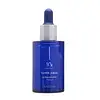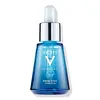What's inside
What's inside
 Key Ingredients
Key Ingredients

 Benefits
Benefits

 Concerns
Concerns

No concerns
 Ingredients Side-by-side
Ingredients Side-by-side

Water
Skin ConditioningMethylpropanediol
SolventGlycerin
HumectantCyclohexasiloxane
Emollient1,2-Hexanediol
Skin ConditioningNiacinamide
SmoothingPolyglycerin-3
HumectantAvena Sativa Kernel Extract
AbrasiveCynara Scolymus Leaf Extract
Skin ConditioningGlycine Soja Seed Extract
Skin ConditioningCamellia Sinensis Leaf Water
MaskingSodium Hyaluronate
HumectantHydrogenated Lecithin
EmulsifyingCitrus Aurantium Dulcis Peel Oil
MaskingCitrus Aurantium Bergamia Fruit Oil
MaskingLavandula Angustifolia Oil
MaskingAnthemis Nobilis Flower Oil
MaskingOctyldodeceth-16
EmulsifyingAmmonium Acryloyldimethyltaurate/Vp Copolymer
Xanthan Gum
EmulsifyingAdenosine
Skin ConditioningMethyl Diisopropyl Propionamide
MaskingCarbomer
Emulsion StabilisingDisodium EDTA
Tromethamine
BufferingPolyquaternium-51
Skin ConditioningBeta-Glucan
Skin ConditioningHydroxypropyltrimonium Hyaluronate
Hydrolyzed Sodium Hyaluronate
Skin ConditioningSodium Acetylated Hyaluronate
HumectantPropanediol
SolventHydrolyzed Hyaluronic Acid
HumectantTetradecyl Aminobutyroylvalylaminobutyric Urea Trifluoroacetate
Skin ConditioningHyaluronic Acid
HumectantMagnesium Chloride
Sodium Hyaluronate Crosspolymer
HumectantArginine
MaskingTetrahydropiperine
Skin ConditioningPotassium Hyaluronate
Skin ConditioningPhloretin
AntioxidantEthylhexylglycerin
Skin ConditioningPentylene Glycol
Skin ConditioningLimonene
PerfumingLinalool
PerfumingWater, Methylpropanediol, Glycerin, Cyclohexasiloxane, 1,2-Hexanediol, Niacinamide, Polyglycerin-3, Avena Sativa Kernel Extract, Cynara Scolymus Leaf Extract, Glycine Soja Seed Extract, Camellia Sinensis Leaf Water, Sodium Hyaluronate, Hydrogenated Lecithin, Citrus Aurantium Dulcis Peel Oil, Citrus Aurantium Bergamia Fruit Oil, Lavandula Angustifolia Oil, Anthemis Nobilis Flower Oil, Octyldodeceth-16, Ammonium Acryloyldimethyltaurate/Vp Copolymer, Xanthan Gum, Adenosine, Methyl Diisopropyl Propionamide, Carbomer, Disodium EDTA, Tromethamine, Polyquaternium-51, Beta-Glucan, Hydroxypropyltrimonium Hyaluronate, Hydrolyzed Sodium Hyaluronate, Sodium Acetylated Hyaluronate, Propanediol, Hydrolyzed Hyaluronic Acid, Tetradecyl Aminobutyroylvalylaminobutyric Urea Trifluoroacetate, Hyaluronic Acid, Magnesium Chloride, Sodium Hyaluronate Crosspolymer, Arginine, Tetrahydropiperine, Potassium Hyaluronate, Phloretin, Ethylhexylglycerin, Pentylene Glycol, Limonene, Linalool
Water
Skin ConditioningNiacinamide
SmoothingPropanediol
SolventPEG-6
HumectantPEG/PPG/Polybutylene Glycol-8/5/3 Glycerin
HumectantGlycerin
HumectantMethyl Gluceth-20
HumectantPEG-60 Hydrogenated Castor Oil
EmulsifyingCarbomer
Emulsion StabilisingSodium Hyaluronate
HumectantTocopherol
AntioxidantHydroxyacetophenone
AntioxidantCitric Acid
BufferingVitreoscilla Ferment
Skin ConditioningCaprylyl Glycol
EmollientBiosaccharide Gum-1
HumectantMaltodextrin
AbsorbentButylene Glycol
HumectantWater, Niacinamide, Propanediol, PEG-6, PEG/PPG/Polybutylene Glycol-8/5/3 Glycerin, Glycerin, Methyl Gluceth-20, PEG-60 Hydrogenated Castor Oil, Carbomer, Sodium Hyaluronate, Tocopherol, Hydroxyacetophenone, Citric Acid, Vitreoscilla Ferment, Caprylyl Glycol, Biosaccharide Gum-1, Maltodextrin, Butylene Glycol
 Reviews
Reviews

Ingredients Explained
These ingredients are found in both products.
Ingredients higher up in an ingredient list are typically present in a larger amount.
Carbomer is a polymer of acrylic acid. Its main role is to create a gel consistency.
A high amount of carbomer can cause pilling or balling up of products. Don't worry, most products contain 1% or less of carbomer.
Glycerin is already naturally found in your skin. It helps moisturize and protect your skin.
A study from 2016 found glycerin to be more effective as a humectant than AHAs and hyaluronic acid.
As a humectant, it helps the skin stay hydrated by pulling moisture to your skin. The low molecular weight of glycerin allows it to pull moisture into the deeper layers of your skin.
Hydrated skin improves your skin barrier; Your skin barrier helps protect against irritants and bacteria.
Glycerin has also been found to have antimicrobial and antiviral properties. Due to these properties, glycerin is often used in wound and burn treatments.
In cosmetics, glycerin is usually derived from plants such as soybean or palm. However, it can also be sourced from animals, such as tallow or animal fat.
This ingredient is organic, colorless, odorless, and non-toxic.
Glycerin is the name for this ingredient in American English. British English uses Glycerol/Glycerine.
Learn more about GlycerinNiacinamide is a multitasking form of vitamin B3 that strengthens the skin barrier, reduces pores and dark spots, regulates oil, and improves signs of aging.
And the best part? It's gentle and well-tolerated by most skin types, including sensitive and reactive skin.
You might have heard of "niacin flush", or the reddening of skin that causes itchiness. Niacinamide has not been found to cause this.
In very rare cases, some individuals may not be able to tolerate niacinamide at all or experience an allergic reaction to it.
If you are experiencing flaking, irritation, and dryness with this ingredient, be sure to double check all your products as this ingredient can be found in all categories of skincare.
When incorporating niacinamide into your routine, look out for concentration amounts. Typically, 5% niacinamide provides benefits such as fading dark spots. However, if you have sensitive skin, it is better to begin with a smaller concentration.
When you apply niacinamide to your skin, your body converts it into nicotinamide adenine dinucleotide (NAD). NAD is an essential coenzyme that is already found in your cells as "fuel" and powers countless biological processes.
In your skin, NAD helps repair cell damage, produce new healthy cells, support collagen production, strengthen the skin barrier, and fight environmental stressors (like UV and pollution).
Our natural NAD levels start to decline with age, leading to slower skin repair, visible aging, and a weaker skin barrier. By providing your skin niacinamide, you're recharging your skin's NAD levels. This leads to stronger, healthier, and younger looking skin.
Another name for vitamin B3 is nicotinamide. This vitamin is water-soluble and our bodies don't store it. We obtain Vitamin B3 from either food or skincare. Meat, fish, wheat, yeast, and leafy greens contain vitamin B3.
The type of niacinamide used in skincare is synthetically created.
Learn more about NiacinamidePropanediol is an all-star ingredient. It softens, hydrates, and smooths the skin.
It’s often used to:
Propanediol is not likely to cause sensitivity and considered safe to use. It is derived from corn or petroleum with a clear color and no scent.
Learn more about PropanediolSodium Hyaluronate is hyaluronic acid's salt form. It is commonly derived from the sodium salt of hyaluronic acid.
Like hyaluronic acid, it is great at holding water and acts as a humectant. This makes it a great skin hydrating ingredient.
Sodium Hyaluronate is naturally occurring in our bodies and is mostly found in eye fluid and joints.
These are some other common types of Hyaluronic Acid:
Learn more about Sodium HyaluronateWater. It's the most common cosmetic ingredient of all. You'll usually see it at the top of ingredient lists, meaning that it makes up the largest part of the product.
So why is it so popular? Water most often acts as a solvent - this means that it helps dissolve other ingredients into the formulation.
You'll also recognize water as that liquid we all need to stay alive. If you see this, drink a glass of water. Stay hydrated!
Learn more about Water